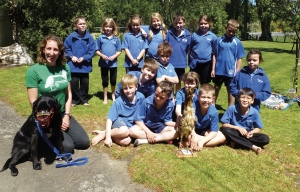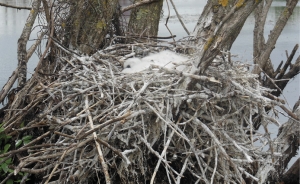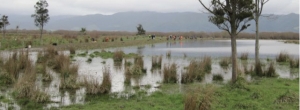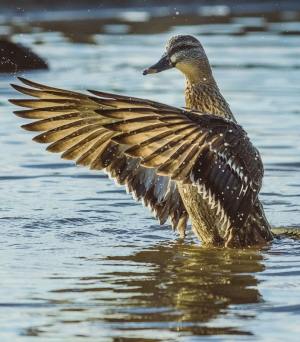Super User
Seabird Award winners set examples
Winners of the 2015 Seabird Smart Awards have changed the behaviour of their entire fishing fleet to ensure the wellbeing of seabirds.
Bill Mansfield, chair of the Southern Solutions Seabird Trust, pointed out that New Zealand had an international responsibility to ensure the long term survival of seabirds.
Tom Searle, operations manager of Leigh Fisheries and Mike Black of Talley’s were the main winners. Both have instigated significant change on vessels in the way engagement with seabirds is managed and in raising awareness of the impact of fishing on the birds.
Special awards were given to fisher Wayne Dreadon for championing collaboration with environmental groups and fisheries observer Jamie Willimason for giving fishers a new appreciation of the seabirds they see every day
The Southern Seabird Solutions Trust is a collaboration between seafood industry representatives, the Government, WWF-New Zealand, Te Ohu Kaimoana and recreational anglers to ensure a sustainable future for fishing.
Keep alert – invaders are everywhere
Keep alert – invaders are everywhere
No 1: Velvertleaf.
As of Wednesday April 20, Velvetleaf had been confirmed on 196 properties in 11 regions of New Zealand. This number is expected to increase as the Ministry for Primary Industries (MPI) continue to visit properties in Otago and Southland known to have planted the Kyros or Bangor fodder beet varieties.
More and more unwanted problems and pests are invading out lovely country. We need to be alert and make sure caring people like Ducks Unlimited members keep a look out for problems.
Velvetleaf is one of the world’s worst cropping weeds and it is just about everywhere fodder beet has been planted this season.
Velvertleaf is an annual board leafed herb that grows up to 2.5m tall. It has large heart shaped leaves, velverty to the touch. It flowers from spring through to autumn with yellow flowers about 3cm across.
It crows in crops, if you think it might be on your place contact Ministry for Primary Industries (MPI) 0800 08 99 66. Advice it not to pull up the plants but contact MPI.
No 2: Honeybees.
Our little helpers are in danger of memory deficits and learning. Even low levels of pesticide can harm the bees. It means they lose the ability to recall odours and worse they lose their odour-learning abilities.
Bees rely on memory to target flowers, but exposure to various sprays appears to be stunting their effectiveness as nectar foragers and pollinators.
Researchers at Otago University tested bees from 51 hives at 17 sites in Otago and tested their pesticide chlorphyrifos levels. Low levels of the pesticide were found in bees at three ofthe sites.
In 2013 the team from Otago’s Department of Chemistry showed chlorpyrifos was detectable in air, water and plant samples, and even in non-sprayed areas as it had a high ability to volatilise and travel great distances.
Most uses of the chemical have been banned in Britain since April 1 this year.
No 3: Blackgrass.
Now there is Blackgrass. It was detected during routine sampling of rye grass seed in Canterbury in February.
It seems to be an isolated incident, but farmers should stay alert and are urged that a thorough investigation should be undertaken to trace all potentially contaminated material.
Blackgrass is an invasive plant that is difficult to contain once it spreads. It competes with winter crops for light, nutrients, space and water, resulting in yield loss and increased cultivation costs that could be potentially devastating to the New Zealand Arable Industry.
Urban bittern chicks
Urban bittern chicks get into strife
Now, if I was to ask how many of you have seen a juvenile bittern or a bittern nest, I think it’d be safe to assume that most of you haven’t. And that’s saying a lot given that you are all wetland enthusiasts who regularly work and play in these kind of habitats.
So when we got a report that a female bittern chick had been found wandering along a road in Christchurch you can imagine our surprise. What was one of the most cryptic and secretive wetland birds doing on a road in the city? And the surprises didn’t end there – a few weeks later a second female bittern chick walked into a residential garage, only 500m from the location where the first bittern was found.
There had to be a nest nearby – but where?
Both bitterns were very skinny and clearly dehydrated. They were taken to bird rehabilitator Jackie Stevenson, who set about trying to fatten them up and get them feeding for themselves. In the meantime, local ornithologist Peter Langlands set about trying to find their nest.
Now this is no easy task. Bittern nests are tricky to find. A broody female bittern will build her nest by bending blades of raupo to form a floating platform that is perfectly hidden in the thick vegetation. And she’s not necessarily alone. Male bitterns can have multiple females, which all appear to nest within close proximity to each other.
Once a mother-to-be is happy with her nest she’ll lay between 3 and 5 eggs before starting to incubate. She hatches the eggs and rears the chicks alone, apparently chasing the male away if he tries to get too close. While incubating, she’s almost impossible to see as her streaked plumage blends perfectly in with the surrounding vegetation. Occasionally she’ll slip silently off the nest to feed, but only momentarily as this leaves her eggs vulnerable to predators.
After about 25 days, her eggs will hatch to produce little fluffy chicks with Albert Einstein inspired hairdo’s. These fuzz balls, emerge as masters of disguise straight from the eggs, and will adopt a perfect ‘freeze pose’ that looks similar to that of the adults if they are disturbed. Chicks fledge at about seven weeks old. However, there is some suggestion that they may start wandering from the nest as early as two weeks old - which is perhaps how one chick ended up on a city road and the other in a household garage.
Midway between the locations where these two birds were found lies Travis wetland, a 120 hectare swamp complex that has been restored over the last 15 years by the Travis wetland trust and the Christchurch council. It is the most likely place where these two birds came from. As it happens Travis is a noteworthy place, with an interesting history. In the 1960’s, this beautiful wetland was under threat from developers, who wanted to convert it to a residential area. Luckily, the locals had other ideas. They realised the importance of the site’s natural biodiversity, and argued long and hard for its protection. After a long battle that involved a petition signed by almost 7000 people, biodiversity won out, and in 1997 the site became a natural heritage park.
And lucky for bitterns that it did!
Since then, these two bitterns have done well in captivity and we were able to release them over the festive season - one along the Waimakariri river and the other at Harts Creeks. We attached radio transmitters to both bitterns, one of which was kindly funded by Ducks Unlimited. Both of these birds will be tracked regularly by local enthusiasts and, as female survival and breeding success is the secret to saving a species in decline, and these birds are the only females to carry transmitters at the moment - the information we gain will be essential for saving the species.
Emma Williams
And thanks to Gill Lundie for organising the school visit.
Tussock provides shelter and pleasing vista
Widespread in swamps, (Carex secta), is a tussock-forming sedge. Its drooping leaves are rough and can cut the skin. It used to be called niggerhead, a term now considered unacceptably derogatory, because it resembles the feathered head wear of African tribes people, or to describe the plant’s blackened appearance after the fires that swept through swamplands during early European settlement.
There are about 60 known species of Carex in New Zealand’s wetlands – some are hard to distinguish unless they are flowering or in seed.
Ian Jensen
Spoonbills at Boggy Pond and surrounds
The photo is of spoonbill chicks in a nest early this year. The nest itself is a pretty loose affair of sticks placed in the base of a dead willow tree and surrounded by open water on all sides. As the chicks age the nest becomes a lot whiter, the result of droppings from both the chicks and their parents.
This was the first record of spoonbills nesting at Boggy Pond and only the second for Wairarapa.
They have been seen more often in the wider area over the past few years with the increased area of shallow wetland created by DU’s Wairio restoration project likely to be providing a good reliable food source.
I think, also, that the predator control in the area has been a big part of supporting these nests once they start and giving the youngsters a decent chance of fledging.
We hope that this is the first of many!
Earlier in the year a team took the canoe to chase and spray purple loosestrife.
On the way out we noted a big flock of spoonbills at the northern end of the lagoon and on the way back we came across some nests in the bases of sprayed willows.
We didn’t approach too closely, but through the telephoto it looked like two chicks at least in each.
It was quite a shock to come across these, a pleasant one too, as you’d imagine. This is the second confirmed nesting site at Wairarapa Moana.
We plan to follow up the loosestrife work and will check on these chicks and have a look over a wider area to see if there are more.
I think this is a result of the combination of willow spraying opening up the lagoon and creating the right conditions for nest building and the pest control keeping the nests alive instead of providing food for hungry mammals.
Tony Silbery
Kaiarahi- Koiora Rereketanga (Ranger, biodiversity) DoC.
Duck broods under constant threat from predators
Southland has long been recognised for its duck population and the associated buzz around the district during the first weekend in May!
However, the combination of several poor mallard breeding seasons in a row and in response to hunters concerns about the struggling North Island population, the Southland Fish and Game Council funded a national mallard research project. I was fortunate to have my Master’s research funded as part of this wider project.
The Southland Council had expressed concern about continual dairy conversions and the associated changes in pasture management that might affect duckling survival. Consequently, for my research I focused on female habitat selection and factors that may impact duckling survival.
In terms of pasture management, I found that duckling survival is comparable between dairy and sheep/deer pastoral grazing systems. This is good news for mallards in Southland, as we readily see our landscape convert to dairying systems. However, first and foremost, broodrearing females in Southland are selecting for ‘unmanaged habitat’ i.e., everything that is not pasture (hedgerows, shelterbelts, rank grass). This may not seem like an unexpected result, but alarmingly, these types of habitat are associated with lower duckling survival.
In our landscape, these habitats are typically thin and linear in configuration, creating ideal travelling corridors for predators. While broods may feel safe and protected tucked up in a hedgerow, predators that rely on their olfactory sensory system to track prey can easily run along the downwind side of these strips and pick up the scent of a sitting duck.
Additionally, I found that duckling survival is reduced for broods that spend their time closer to houses and roads, with both being structures that tend to be associated with a higher predator presence. Over the two year study period, 15-25 percent of our breeding females were killed on the nest by predators. To put this figure in context, this is similar to the proportion that we, as hunters, shoot each year. Further, an additional 30 percent of nests last season were abandoned or destroyed due to predators. At necropsy (post mortem examination), many of these females had evidence suggesting both mustelids and cats were the main perpetrators. While more research is needed, these results suggest that predators are having a much bigger impact on our mallard population than we originally suspected. Luckily, predator abundance is a factor that we can all influence. Further, in reducing the predator guild, you may be surprised in what other wildlife you attract!
Operation duck pond
After chasing ducks through the 2014 breeding season, staff noticed definite differences in ponds that were used by ducks and broods. Consequently, over the 2015 breeding season, we deployed 21 game cameras on ponds throughout the region that captured images every five minutes during daylight hours. If you do the math, that means I have roughly 250,000+ photos to wade through! As a result, I have not quite made it through all these photos to run the analysis. However, I can make a few comments on factors that seem to have an impact on the ponds I have made it through thus far.
Typically, the shallower ponds with plenty of feeding bottom (at least 43cm deep) have had hundreds of headless, ‘bums-up’ photos. Another example is a pond that only has water in it during the breeding season. These seasonal bodies of water tend to be the most productive in terms of invertebrate presence, and this may flow through into brood use. In last year’s study, I found that the presence of ephemeral water (short-lived bodies of water) during the first 10 days of a ducklings life, had a huge impact on survival. For Southland, cumulative duckling survival to 30 days of age without ephemeral (lasting only a short time), water present was only 11 percent for broods raised by yearling females compared to 26 percent for broods raised by adult females. However, with the presence of ephemeral water, duckling survival dramatically increased to 28 percent for broods raised by yearling females and 46 percent for broods raised by adult females. Initially, ducklings require a high protein food source, which is readily available in ephemeral water, particularly in the form of earthworms that are forced to the surface. Hence, this may be why Southland is recognised as a duck factory, and as duck enthusiasts, we shouldn’t be complaining about the weather! Consequently, management of pond water levels to mimic a seasonal body of water might be one way to encourage duck use of ponds.
Another observation that might be important to brood use is the degree of exposure of the pond to the elements. The more barren-like ponds lacking any edge, bank, or overhead cover tend to have very limited use by any mallards, and none by broods. It will be interesting to see what factors come out of the data, but my gut feeling is pond use by broods is a combination of factors that create a sheltered, food-laden haven…. Watch this space! After chasing ducks through the 2014 breeding season, staff noticed definite differences in ponds that were used by ducks
Erin Garrick
Wairio restoration planning and farewell
The presentation of DUNZ’s certificate “in recognition and appreciation of support to NZ’s waterfowl and wetland habitat” to Ian Gunn from Greater Wellington Regional Council (GWRC) – Manager of GWRC’s Wairarapa Moana Project and a great supporter of the Wairio Wetland Restoration Project.
Ian was critical in securing a “step change” in funding for the project. The presentation was made at the end of the meeting along with the small gift of a bottle of wine. DUNZ members may recall Ian joining us at our 2014 AGM in Martinborough.
The recent meeting was held at Fish & Game’s Kilmore Lodge, adjacent to the Wetland where the group planning the 2016 work programme was underway.
Funding currently tots up to around $30,000. Of this, about $20,000 is already funded by contributions from our supporters.
Whio freedom
A great day out at Ruatiti Domain on the Manganui a te Ao River where we released 12 captive reared Whio, 7 females and 5 males. We had a good turn out with school children, Iwi, Horizon councillors, land owners, two Orana Park staff who released one of the Whio they had raised, a film crew and Doc staff, interested visitors and Anne and me. The Whio were reared by staff at Peacock Springs, Orana Park and Mt Bruce.
Peter Russell.
Eds note: The Manganui a te Ao River starts on the western flank of Mt Ruapehu and flows westward through forest and steep hill country north-west of Raetihi, Waimarino County, Taihape and then joins the Wanganui River. The name means - stream; great; of; the; world.
Letter to Ed
Thank you Liz, for another excellent Flight magazine. Full of interest. It’s always been a strong point of DUNZ.
I particularly enjoyed the Whio News 2015 (page 14) and the “Ghost flow” photo of the whio of very pale colouring that had set up on the Whakapapanui. Peter Russell will have been well aware, but I think it’s worth mentioning that the bird is of the leucistic colour phase. Leucism is an abnormal plumage condition, caused by a genetic mutation that prevents pigment, particularly melanin (which produces black), from being deposited in a bird’s feathers. It occurs also in Black swan (personal comment Ken Meirs). It occurs too in animals. I treasure a photo I took many years ago of this leucistic chamois (right) which had been netted in the Waiau river country.
Howard Egan.
My favourite New Zealand duck
Jamie Steer University of Auckland
I was talking with a guy the other day about ducks and somehow got on to discussing favourites. His was the blue duck because it’s on the $10 note.
He said, ‘That’s a bird that knows how to sell itself’.
‘Maybe that’s true,’ I said, ‘but I haven’t seen many around recently so I wouldn’t know’.
We agreed that they had a pretty great strategy 800 years ago. Good for them.
I told him my favourite was the New Zealand grallard, the bastard love child of the introduced mallard and the native grey duck, and now New Zealand’s most common duck. This at first seemed to both perplex and bewilder him but, once he’d settled down, I ran him through my reasons and in the end he accepted that I’d made the more compelling choice.
This is basically what I said.
Grallards are one of the world’s newest birds. They came into existence not long after mallards were introduced to New Zealand in the mid-19th Century. Mallards took a shining (wink wink) to the grey duck and the rest is history. From what I hear the grey is partial to a bit of mallard action too so it’s a veritable love in. People talk a lot about birds that haven’t changed in ages but I like the versatile new chick on the block.
Grallards are all over the place. I drive around a bit and there aren’t many water bodies I don’t see grallards on. Clearly they’re loving it here. People shoot a tonne of them every year and they just keep coming back. They’re the duck version of The Terminator. I respect a bird that can take all the crap people have thrown at them over the years and still keep on kicking. I take my son down to feed the ducks and they’re always there ready and obliging.
Grallards are unique to New Zealand. I searched around and haven’t found grallards anywhere but here. There’s something similar in Australia but they’re derived from mallards mixed with the Australian sub-species of grey duck. I reckon they look different over there too. It’s neat to have another locally unique duck, especially one that’s got such an interesting history. Millions of years of evolution in those genes and it didn’t end with their parent species. They’re the biological version of fusion cuisine.
Grallards could teach people a thing or two. Some people are so distraught about losing biodiversity that they can’t see the gains happening right in front of them. Grallards have accepted people and the changed environments that they live in. They don’t distinguish between native and introduced species, or between pristine and modified environments. They get on with living their lives and the world is a more diverse, interesting and vibrant place for it. While some other species have ‘evolutionary potential’ grallards are busy realising theirs.
It’s like they’re sitting there quaking, ‘Here I am loving life and the world isn’t going to end’.
Maybe there’s a lesson in there, I don’t know.
Jamie Steer





